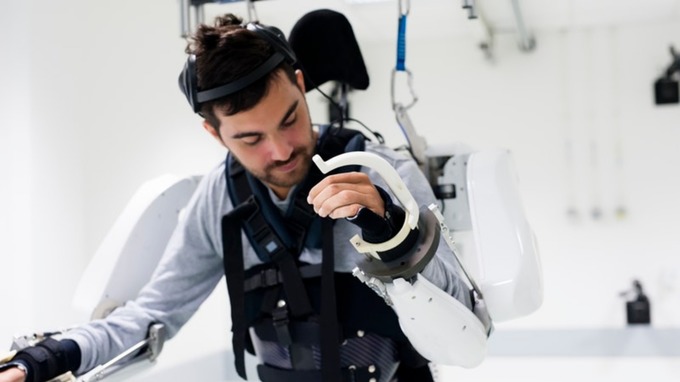A quadriplegic has been able to walk and use his arms again after being fitted with a robotic skeleton controlled by his mind.
The 30-year-old, named only as Thibault, was paralysed from the neck down in 2015 after falling 50 feet (15m) from a nightclub roof.
The study successfully trialled a four-limb robotic system, and the authors say that, once some necessary major improvements are available, it could have the potential to improve patients’ quality of life and autonomy, but for now it is an experimental treatment far from clinical application.
“Ours’ is the first semi-invasive wireless brain-computer system designed for long term use to activate all four limbs,” says Professor Alim-Louis Benabid, President of the Clinatec Executive Board, a CEA laboratory, and Professor Emeritus from the University of Grenoble, France. “Previous brain-computer studies have used more invasive recording devices implanted beneath the outermost membrane of the brain, where they eventually stop working. They have also been connected to wires, limited to creating movement in just one limb, or have focused on restoring movement to patients’ own muscles.”
“Although this study presents a welcome and exciting advance, we must remember that proof of concept is a long way from usable clinical possibility,” observed Tom Shakespeare, PhD, of the London School of Hygiene and Tropical Medicine in England, in an accompanying editorial. “A danger of hype always exists in this field. Even if ever workable, cost constraints mean that high-tech options are never going to be available to most people in the world with spinal cord injury.”
Many people with spinal cord injury can use highly effective control systems for hoists, beds, cars, and most other areas of daily life, Shakespeare noted. “Often, making environments accessible or providing appropriate assistive technology is more effective than trying to fix individuals with injury, particularly in low-income settings,” he wrote. “However, our dominant medical mindset seems always to have wanted to make the paralyzed walk.”
About 20% of patients with cervical spinal cord injury have tetraplegia, meaning that all four limbs are partially or completely paralyzed; the extent of their deficit depends on the type of spinal cord lesion. This trial involved a 28-year-old man who had tetraplegia following a C4-C5 spinal cord injury. He was paralyzed from the shoulders down and had some movement in his biceps at the elbow and in his left wrist only. He could operate a wheelchair using a joystick controlled with his left arm.
The study’s brain-computer interface platform included two remotely powered electrocorticography (ECoG) recording devices, each with 64 electrodes, implanted over the upper limb sensorimotor areas. The recorders collected ECoG signals transmitted to an adaptive decoding algorithm to send commands to either a virtual avatar or an exoskeleton.
During the 2-year study, the patient performed various mental tasks to train the algorithm, controlling a virtual avatar to play a video game similar to Pong, reaching for targets with the avatar or exoskeleton, and simulating walking.
Progress was measured by the number of degrees of freedom (ways of movement through different dimensions) he achieved. From June 2017 to July 2019, the patient cortically controlled the program to simulate walking and made upper limb movements involving both arms with up to 8 degrees of freedom simultaneously. With a virtual avatar at home, he achieved 64% success; with an exoskeleton in the laboratory, he achieved 70.9% success.
The decoders could be used for up to 7 weeks without recalibration. “Decoders’ stability over a long period for brain-computer interface is a crucial point,” Charvet explained. “[Stability] has been reported previously, but only for low dimensional control, therefore restricting the scope of clinical application. Our high-dimensional decoder, stable for several weeks, is innovative.”
Three further patients have been recruited and the trial is ongoing. The next goal of the researchers is to solve the problem of allowing a patient to walk and balance autonomously without using a ceiling suspension system.















